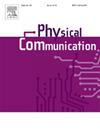Unveiling the power of features: A comparative study of machine learning and deep learning for modulation recognition
IF 2.2
4区 计算机科学
Q3 ENGINEERING, ELECTRICAL & ELECTRONIC
引用次数: 0
Abstract
Wireless communication systems rely on amplitude, frequency, and phase parameters for signal transmission. Traditional modulation recognition (MR) techniques, employing likelihood-based (LB) and feature-based (FB) methods, struggle with accurate classification, particularly at low signal-to-noise ratios (SNR) and increasing modulation complexity. Machine learning (ML) and deep learning (DL) algorithms, which efficiently utilize in-phase/quadrature (IQ) and -radius/-angle ( data representations to enhance MR performance. DL, utilizing artificial neural networks (ANN), minimizes the need for extensive feature engineering, making it adept at handling diverse modulation types and challenging SNR conditions. This study systematically examines dataset generation parameters to reveal their impact on MR performance. By focusing on these underlying parameters, the analysis provides deeper insights into how data characteristics influence model performance, offering a foundational understanding for optimizing dataset configurations in MR tasks. Evaluating ML and DL models across datasets, results show DL model consistently outperforms ML models, achieving up to 79.41 % accuracy on IQ-based datasets. DL's hierarchical feature extraction enhances adaptability, particularly with larger datasets, reduced window lengths (WL), and specific ranges (e.g., radians or smaller degree intervals). For ML models, datasets based on IQ, , and IQ parameters yield better results but remain below 70 % accuracy. Overall, DL model exhibits robust adaptability to complex signal environments, highlighting their effectiveness in advancing modulation recognition for next-generation wireless communication systems.
揭示特征的力量:调制识别中机器学习和深度学习的比较研究
无线通信系统依赖于信号传输的幅度、频率和相位参数。传统的调制识别(MR)技术,采用基于似然(LB)和基于特征(FB)的方法,难以准确分类,特别是在低信噪比(SNR)和增加调制复杂性的情况下。机器学习(ML)和深度学习(DL)算法,它们有效地利用同相/正交(IQ)和r-半径/θ-角度(rθ)数据表示来增强MR性能。深度学习利用人工神经网络(ANN),最大限度地减少了对大量特征工程的需求,使其擅长处理各种调制类型和具有挑战性的信噪比条件。本研究系统地考察了数据集生成参数,以揭示它们对MR性能的影响。通过关注这些基本参数,分析可以更深入地了解数据特征如何影响模型性能,为优化MR任务中的数据集配置提供基础理解。跨数据集评估ML和DL模型,结果显示DL模型始终优于ML模型,在基于iq的数据集上达到高达79.41%的准确率。深度学习的分层特征提取增强了适应性,特别是对于更大的数据集,减少窗口长度(WL)和特定的θ范围(例如,弧度或更小的度间隔)。对于ML模型,基于IQ, rθ和IQrθ参数的数据集可以产生更好的结果,但准确率仍低于70%。总体而言,DL模型显示出对复杂信号环境的强大适应性,突出了它们在推进下一代无线通信系统调制识别方面的有效性。
本文章由计算机程序翻译,如有差异,请以英文原文为准。
求助全文
约1分钟内获得全文
求助全文
来源期刊

Physical Communication
ENGINEERING, ELECTRICAL & ELECTRONICTELECO-TELECOMMUNICATIONS
CiteScore
5.00
自引率
9.10%
发文量
212
审稿时长
55 days
期刊介绍:
PHYCOM: Physical Communication is an international and archival journal providing complete coverage of all topics of interest to those involved in all aspects of physical layer communications. Theoretical research contributions presenting new techniques, concepts or analyses, applied contributions reporting on experiences and experiments, and tutorials are published.
Topics of interest include but are not limited to:
Physical layer issues of Wireless Local Area Networks, WiMAX, Wireless Mesh Networks, Sensor and Ad Hoc Networks, PCS Systems; Radio access protocols and algorithms for the physical layer; Spread Spectrum Communications; Channel Modeling; Detection and Estimation; Modulation and Coding; Multiplexing and Carrier Techniques; Broadband Wireless Communications; Wireless Personal Communications; Multi-user Detection; Signal Separation and Interference rejection: Multimedia Communications over Wireless; DSP Applications to Wireless Systems; Experimental and Prototype Results; Multiple Access Techniques; Space-time Processing; Synchronization Techniques; Error Control Techniques; Cryptography; Software Radios; Tracking; Resource Allocation and Inference Management; Multi-rate and Multi-carrier Communications; Cross layer Design and Optimization; Propagation and Channel Characterization; OFDM Systems; MIMO Systems; Ultra-Wideband Communications; Cognitive Radio System Architectures; Platforms and Hardware Implementations for the Support of Cognitive, Radio Systems; Cognitive Radio Resource Management and Dynamic Spectrum Sharing.
 求助内容:
求助内容: 应助结果提醒方式:
应助结果提醒方式:


